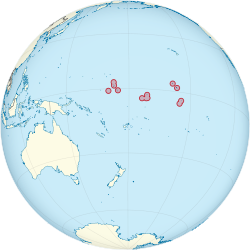Kiribati
From Wikipedia, the free encyclopedia
This article is about the island nation. For other uses, see Kiribati (disambiguation).
Not to be confused with Kiritimati, an island in the Line Islands and part of Kiribati.
| Republic of Kiribati
Ribaberiki Kiribati
| ||||||
|---|---|---|---|---|---|---|
| ||||||
| Motto: "Te Mauri, Te Raoi ao Te Tabomoa" "Health, Peace and Prosperity" | ||||||
| Anthem: Teirake Kaini Kiribati Stand up, Kiribati | ||||||
|
| ||||||
| Capital and largest city | Tarawa[1][2][3] 1°28′N 173°2′E | |||||
| Official languages | ||||||
| Ethnic groups (2000) | 98.8% Micronesian 1.2% others[4] | |||||
| Demonym | I-Kiribati | |||||
| Government | Presidential republic | |||||
| • | President | Anote Tong | ||||
| • | Vice-President | Teima Onorio | ||||
| Legislature | House of Assembly | |||||
| Independence | ||||||
| • | from the United Kingdom | 12 July 1979 | ||||
| Area | ||||||
| • | Total | 811 km2 (186th) 313 sq mi | ||||
| Population | ||||||
| • | 2010 estimate | 103,500 (197th) | ||||
| • | 2010 census | 103,500 | ||||
| • | Density | 135/km2 (73rd) 350/sq mi | ||||
| GDP (PPP) | 2011 estimate | |||||
| • | Total | $599 million[5] | ||||
| • | Per capita | $5,721[5] | ||||
| GDP (nominal) | 2011 estimate | |||||
| • | Total | $167 million[5] | ||||
| • | Per capita | $1,592[5] | ||||
| HDI (2014) | medium · 137th | |||||
| Currency | Kiribati dollar Australian dollar (AUD) | |||||
| Time zone | (UTC+12, +13, +14) | |||||
| Drives on the | left | |||||
| Calling code | +686 | |||||
| ISO 3166 code | KI | |||||
| Internet TLD | .ki | |||||
Kiribati (/ˌkɪrɪˈbæs/; keer-ə-bahss or /ˌkɪrɪˈbɑːti/; keer-ə-bah-tee),[7] officially the Republic of Kiribati (Gilbertese: Ribaberiki Kiribati),[8][9][10][11][12] is an island nation in the central Pacific Ocean. The nation comprises 33 atolls and reef islands and one raised coral island; Banaba. They have a total land area of 800 square kilometres (310 sq mi)[13] and are dispersed over 3.5 million square kilometres (1,351,000 square miles). Their spread straddles the equator and the International Date Line, although the Date Line is indented to bring the Line Islands in the same day as the Kiribati Islands. The permanent population is just over 100,000 (2011), half of whom live on Tarawa Atoll.
Kiribati became independent from the United Kingdom in 1979. The capital and now most populated area, South Tarawa, consists of a number of islets, connected by a series of causeways. These comprise about half the area of Tarawa Atoll.
Kiribati is a member of the Commonwealth of Nations, the IMF and the World Bank, and became a full member of the United Nations in 1999.
Contents
[hide]- 1Etymology
- 2History
- 3Politics
- 4Geography
- 5Economy
- 6Demographics
- 7Culture
- 8Bibliography
- 9See also
- 10References
- 11External links





